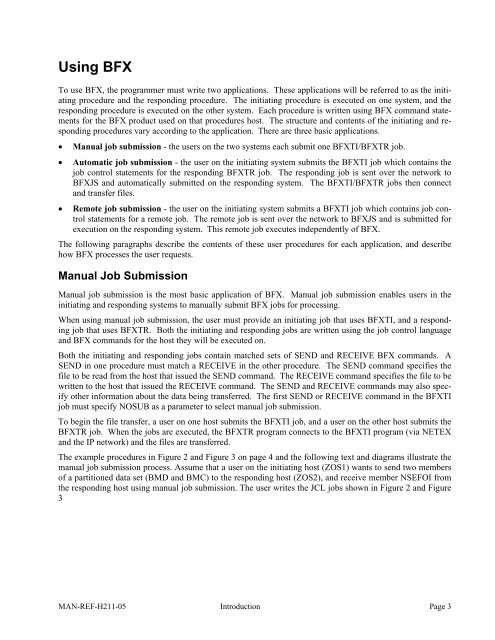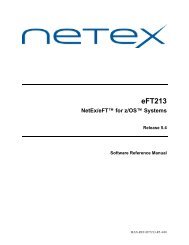Software Reference Manual - NetEx
Software Reference Manual - NetEx
Software Reference Manual - NetEx
You also want an ePaper? Increase the reach of your titles
YUMPU automatically turns print PDFs into web optimized ePapers that Google loves.
Using BFX<br />
To use BFX, the programmer must write two applications. These applications will be referred to as the initiating<br />
procedure and the responding procedure. The initiating procedure is executed on one system, and the<br />
responding procedure is executed on the other system. Each procedure is written using BFX command statements<br />
for the BFX product used on that procedures host. The structure and contents of the initiating and responding<br />
procedures vary according to the application. There are three basic applications.<br />
<br />
<br />
<br />
<strong>Manual</strong> job submission - the users on the two systems each submit one BFXTI/BFXTR job.<br />
Automatic job submission - the user on the initiating system submits the BFXTI job which contains the<br />
job control statements for the responding BFXTR job. The responding job is sent over the network to<br />
BFXJS and automatically submitted on the responding system. The BFXTI/BFXTR jobs then connect<br />
and transfer files.<br />
Remote job submission - the user on the initiating system submits a BFXTI job which contains job control<br />
statements for a remote job. The remote job is sent over the network to BFXJS and is submitted for<br />
execution on the responding system. This remote job executes independently of BFX.<br />
The following paragraphs describe the contents of these user procedures for each application, and describe<br />
how BFX processes the user requests.<br />
<strong>Manual</strong> Job Submission<br />
<strong>Manual</strong> job submission is the most basic application of BFX. <strong>Manual</strong> job submission enables users in the<br />
initiating and responding systems to manually submit BFX jobs for processing.<br />
When using manual job submission, the user must provide an initiating job that uses BFXTI, and a responding<br />
job that uses BFXTR. Both the initiating and responding jobs are written using the job control language<br />
and BFX commands for the host they will be executed on.<br />
Both the initiating and responding jobs contain matched sets of SEND and RECEIVE BFX commands. A<br />
SEND in one procedure must match a RECEIVE in the other procedure. The SEND command specifies the<br />
file to be read from the host that issued the SEND command. The RECEIVE command specifies the file to be<br />
written to the host that issued the RECEIVE command. The SEND and RECEIVE commands may also specify<br />
other information about the data being transferred. The first SEND or RECEIVE command in the BFXTI<br />
job must specify NOSUB as a parameter to select manual job submission.<br />
To begin the file transfer, a user on one host submits the BFXTI job, and a user on the other host submits the<br />
BFXTR job. When the jobs are executed, the BFXTR program connects to the BFXTI program (via NETEX<br />
and the IP network) and the files are transferred.<br />
The example procedures in Figure 2 and Figure 3 on page 4 and the following text and diagrams illustrate the<br />
manual job submission process. Assume that a user on the initiating host (ZOS1) wants to send two members<br />
of a partitioned data set (BMD and BMC) to the responding host (ZOS2), and receive member NSEFOI from<br />
the responding host using manual job submission. The user writes the JCL jobs shown in Figure 2 and Figure<br />
3<br />
MAN-REF-H211-05 Introduction Page 3















